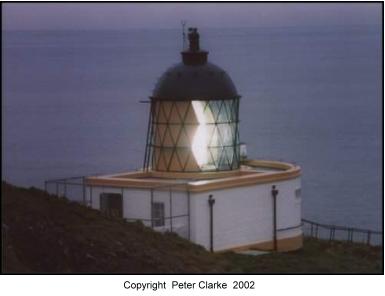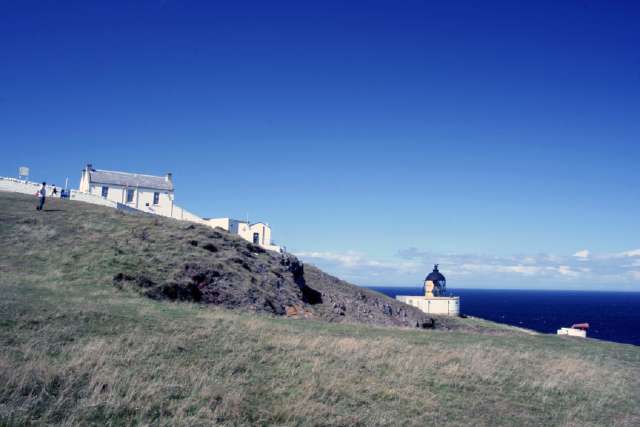 9th.April 1973.
Reported to St.Abbs Head Lighthouse(Berwickshire) to begin training as a Supernumerary Lightkeeper(SLK),once you had completed your initial training you were posted to various lighthouses to do relieving duties.ie.covering for people off sick or being transferred,maybe on a training course,etc.
9th.April 1973.
Reported to St.Abbs Head Lighthouse(Berwickshire) to begin training as a Supernumerary Lightkeeper(SLK),once you had completed your initial training you were posted to various lighthouses to do relieving duties.ie.covering for people off sick or being transferred,maybe on a training course,etc.
Which of course gave you chance to meet a variety of keepers and their families,see different lighthouses,check out lifestyles and see if you personally liked,what at times could be an isolated lifestyle.
You used to do 18 months to 2 years as a SLK,but when I started the "forty hour"week was being introduced.as a result I only did 8 months before becoming an ALK.
Training.
Light.
The light itself was an electric bulb so only required switching on or off.The lens mechanism used an electric motor drive but could in an emergency revert to clockwork,so I was introduced to "The Wind" Rewinding the weight which powered the clockwork mechanism which turned the lens,though in this case only for practise.
Life on duty when the light was "ON" where clockwork drive was used was dominated by "the Wind" which could be from twenty minutes to four hours and whoe betide you if you forgot to rewind and the light was left standing still.
Grounds for instant dismissal.(Showing what was in effect a false character)
Quote from Service Regulations(January 1976)
A.13.FAULT OR NEGLIGENCE WHILST ON DUTY.--If a Light,Fog Signal or Radio navigational Aid fails to operate or if its efficiency becomes impaired through the fault or negligence of a Lightkeeper,the Commissioners may cause action to be taken in accordance with the agreed disciplinary procedures.
If a Lightkeeper culpably or negligently allows a light to become extinguished or to show a false character by becoming stationary or otherwise or if a lightkeeper falls asleep during his watch,the Commissioners may similarly require action to be taken in accordance with disciplinary procedures.
Quote from Service Regulations(April 1972)
B.8 TIME TABLES--The times for lighting and extinguishing the Light are shown on the Time Table in the Lightroom in G.M.T. or B.S.T. whichever is in force.These times are to be adhered to as closely as possible but if in the opinion of the Pricipal Lightkeeper the atmospheric conditions demand it,that is to say in hazy or thick weather or exceptional darkness for the time of day,the light should be exhibited up to half an before and extinguished up to half an hour after the established times.
Fog Signal--Click for an explanation of Fog Signal.operation
The fog signal was a siren type,which meant having diesel engines driving air compressors and filling air receiver tanks.Air pressure was only about 24 psi but quite a large volume was used for each blast.
These were Kelvin Diesel engines which were primed and started on petrol and when warm were transferred to diesel operation.
Quote from Service Regulations(Dec.1967)
E.5 SOUNDING FOG SIGNAL--Whenever visibiliy is restricted by fog,mist,falling snow or rain to less than 4 miles in any direction to seaward of the Station the Fog Signal is to be set in operation and is to continue to sound until the weather clears.
Lightkeepers will appreciate that the Fog Signal is a most important aid to navigation and the Commissioners will,consequently,take a serious view of any failure to sound it.
If doubt exists as to the limit of the visibilty Lightkeepers are reminded that it is better to sound than not to sound.
It's all fine setting limits in daytime,when you can see different landmarks,but often at night you went by how well the beam showed up in the fog.Which is one of those things that only comes from experience.
Once you had decided visibilty was low enough it took 20 to 30 minutes to get the fog signal sounding,so you were quite often a bit hesitant in starting(especially as a trainee) in case it was just a fog bank passing by?.But you learn,when the PLK appears and says"Why? Fred are we not sounding the foghorn,didn't you want to disturb the Sea Gulls?"Sarcasm works surprising well at times!
Radio Operation
St. Abbs Head was the control station for 3 Rock lighthouses.
Bell Rock, Bass Rock and May Island.
Which meant learning how to use Radio Transmitters and Receivers.both VHF and MF.We used to do three check calls a day on VHF and also connect to the telephone network as required.
We also monitored Fidra Lighthouse(Which had been automated some years earlier),a forerunner of things to come with the monitoring center.
Racon---RAdar beaCON
A Radar transponder triggered by the ships radar shows as a point on the radar screen giving distance and bearing followed by dots and dashes depicting the morse code for that particular racon's position.It is a small self-contained piece of equipment that periodically does a self-test and goes beep-beeeep if satisfactory.
Meteorological.
St.Abbs lighthouse and quite a few lighthouses were auxilliary reporting stations for weather observations,which were done every three hours and transmitted to the national data base where they were used for weather forcasts.
St Abbs was also one of nine NLB lighthouses that the public could telephone for Present Weather conditions.
Probably the hardest parts of the training.Learning to take temperatures,working out humidity,rainfall,barometric pressure,visibility etc.and the hardest, reporting types,amounts and height of clouds.I know I spent quite a few hours with the Cloud Observation Handbook hoping to match photographs with real clouds,it seems so simple to do now,but it was all a mystery at the time.
Cleaning.
I was initiated into the art of cleaning brasswork,lens,engines,etc.I think most lightkeepers took a pride in their lighthouse,so things usually stayed bright and tidy.
Watches
At a fog signal station someone is always on duty and you get used to getting up in the middle of the night?
A timetable which was in general use at fog signal stations from 1978.Can be found at Watch Systems
I shared watches with the PLK to start with,but after a time was left to do the watch by myself.A lightkeepers job was not technically difficult,it's more adapting to the lifestyle,if you didn't like it-you left!
Works Orders
Work outwith normal lighthouse duties,such as painting,limewashing,mending walls/fences,repairing roads,cleaning piers(landing places)etc.was paid extra.
A works order would be issued for the required work,submitted back to headquarters with number of hours worked and who had worked them and about three months later,on average,extra pay would appear in your paypacket,well at least we knew we would eventually receive it.
Quote from Service Regulations(January 1976)
H.1 GENERAL.-In addition to the machinery and equipment at the Station Lightkeepers are required ,as far as possible,to keep in good order the buildings,walls,landing places,roads and drains and the Principal Lightkeeper is to see that such maintenance is properly carried out when necessary.
Some stations did works orders at set times eg. 10.00 hours to 13.00 hours,whilst others did them whenever convenient.
|  9th.April 1973.
Reported to St.Abbs Head Lighthouse(Berwickshire) to begin training as a Supernumerary Lightkeeper(SLK),once you had completed your initial training you were posted to various lighthouses to do relieving duties.ie.covering for people off sick or being transferred,maybe on a training course,etc.
9th.April 1973.
Reported to St.Abbs Head Lighthouse(Berwickshire) to begin training as a Supernumerary Lightkeeper(SLK),once you had completed your initial training you were posted to various lighthouses to do relieving duties.ie.covering for people off sick or being transferred,maybe on a training course,etc.